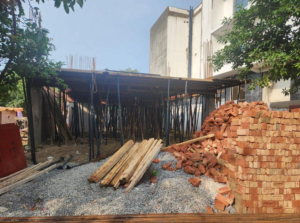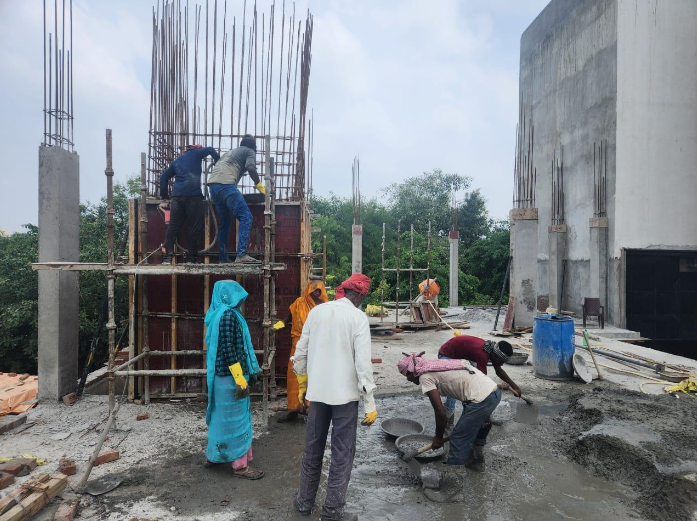How Do I Start House Construction in Noida ?
We would like to enlighen you about the process of House Construction right from beginning the thought of buying or owning a plot and finally entering the grand inviting housing with keys in your hands from the best construction company in Noida.
Your home builder near me can build a Bungalow construction type which means a single family house and is small and square with single story and usually with a front porch.
It could be a Ranch, which is a single story style of a house.They are larger than a bungalow and rectangular in layout . Or it can be a cottage style also which is mainly a vacation home and is quite luxurious.
Some very well off individuals may like to go for building a mansion which could be around 5000 Square feet or more. It means a large size, with beautiful landscaping including a pool and even guest house. Having Lots of rooms, top of the line appliances, entertainment goods and equipments, lots of luxury items and amenities.
Other type of similar houses that may vary depending on location, architecture, and other unique features include castle , palaces, chateaus , villas construction and manors.
Although flat construction near me for your residential purpose is a dream for everyone. However, you have to be very cautious from beginning to end while you get your house constructed right from owning a suitable land for the purpose until the time the construction work is finished by construction contractors near me and you enter your coveted home.
Various stages in the process of construction of a house are summarized and details given after that as follows:
- Pre-Construction stage
- Building Construction stage
- Post Construction stage
- Pre-construction stage:- This stage is very important. So for longevity of your dwelling one has to be cautious.
1.1 Site selection:-
It is a vital step for the construction of the firm foundation of your house. The ground condition should not be prone to water logging .
The soil condition of the site should be such as to have sufficient load carrying capacity. The soil testing for its composition, density, and other properties should be carried out .This is important even for protection from seismic activities . Services of structural Engineer or Geotechnical consultant would be required in case some undesirable characteristics of the soil is detected in which foundation is to be laid.
When it comes to the integrity of the structure which is to be built over the ground plot, it is limited by the safe bearing capacity of the soil ( SBC) , which is foremost important to test before undertaking any construction work on the land.
Two most important criteria of soil failure are Shear Capacity and Settlement Critera, which needs to be taken care in Pre-construction phase.
Besides impacting stability of foundation, soil type and quality testing also help decide foundation design and construction method to be adopted.
Issues such as Soil Erosion, Soil Compaction and presence of Organic material also need to be addressed that could cause soil to shift in Pre-construction stage.
1.2 Compliance with Local Regulations:- Obtain necessary Permits and Approvals from Local Authorities before starting the work. As building codes and regulations are not uniform and are different in region to regions, timely approvals shall avoid unnecessary hefty fines, penalties, delays in the project completion and legal issues.
1.3 Land Title:- is the first approval means your plot should have a clear title along with chain of holdings, transfers , and disputes etc on the ownership for a span of many years.
1.4 Land Clearance:- in case Agricultural land has been converted into non-agricultural land and being used for residential construction , approval from concerned authorities needs to be obtained for land clearance.
1.5 After that you require to obtain Zonal Clearance from local authorities.
You have to submit master construction plan of your home to the local governing body in a graphical representation complying with the building laws. After this one needs to have the layout approved.
Intimation of Disapproval needs to be complied with during phases of
Before, During and After Construction is completed.
1.6 Commencement Certificate needs to be obtained from Local Development Authority before kick starting the Construction of your House.
It is better to obtain approval for amenities such as Gas, electricity, and Water services installation from Local Municipal body at this Pre-construction stage only.
-
Building Construction Stage:-
2.1 Site Preparation:-
2.1.1 Site Clearance: The construction stage starts with clearing the site of any existing structure or vegetation and leveling the earth.
2.1.2 Excavation:- Excavation involves digging the ground and preparing a leveled surface for construction to commence.
A layout plan is formed based on approved drawings. Every pillar and trench excavation line must be marked considering the center lines of all the walls and the work is true to all levels, alignments, shapes and sizes.
2.2 Substructure phase
2.2.1 Foundation Laying :- Foundation work consists of laying the ground work to support the structure to be constructed above. The foundation can be of deep, shallow, pile or raft type depending on the how big and type of the structure is to be built above it. The material used in laying Foundation would consist of concrete and steel .
Soil type, water table depth and seismic conditions would also play a role in the type of foundation to be laid. The Labour work consists of Excavation, construction, reinforcement, formwork and concrete pouring also taking help of specialized equipments.
2.2.2 Anti termite treatment:- To protect your foundation and home from termite attacks soil surrounding the foundation up to the level of plinth must be treated with suitable chemicals.
2.2.3 Drainage system:-
Drainage systems are crucial for managing rainwater, preventing water accumulation around foundation and safeguarding against potential flooding resulting in damage to the structure.
The drainage system Installation work consists of trenching, laying pipes, connecting to appropriate outlets or stormwater management systems.
2.2.4 Laying bricks layer :- Compaction of the excavated soils top layer and addition of brick flat soiling layer on top of it is done. After which a thin layer concrete minimum 6 inches more than size of footing. This work ensures that the home foundation stays on a rigid and flat level base to lay RCC work of the footing and retain moisture content of the footing concrete without any soil soaking.
2.2.5 Wooden Framework –
The next step of foundation building is wooden formwork and is made based on the size of footing, which should be firm enough as reinforcement bars and compacting concrete are placed with its help. To prevent loss of slurry from concrete gaps between formwork should be sealed properly.

2.2.6 Rebar work — Cutting and bending of the Rebar or reinforcement steel is done based on bar bending schedule of the footing to avoid wastage of steel material. To avoid displacement of the Rebar during pouring of concrete suitable concrete cover blocks are used.
2.2.7 Pouring Concrete — The concrete to be poured into the footing must be of approved design grade. Strict quality checks of concrete must be done at regular intervals during this work. Also concrete test cubes of desired numbers need to be checked for their desired crushing strength. Concrete should be compacted and cured properly and adequately. Curing should begin early and continued for sufficient period to make sure , it does not crack and develop the desired strength.
2.3 Structure Phase:-
It is best to consider waterproofing in every step of construction work with all brick work, cement work, foundation, pillars, plastering, rendering, basement and roofslabs using high quality waterproofing liquid compound with cement and sand.
2.3.1 Framing:- Framing is done using materials using wood and steel and is done for walls, floors and roofs.
2.3.2 Roofing :- Depending upon type of roofing materials such as asphalt shingles, clay tiles, metal sheets or composite roofing materials are used . Skilled experienced Labour force is required in the chosen material for roofing and the roof design.
2.3.3 Walls:- For construction of walls materials such as bricks, blocks, concrete panels or wood framing with sheathing are required. Insulation materials for Energy efficiency and sound proofing may also be required. Skilled Labour for brick laying, wooden work along with other menial work is required.
2.3.4 Floors :- Flooring needs materials such as tiles, hardwood, laminate, carpet. For Subflooring materials of plywood, oriented strandboard, insulation materials are also used. Skilled Labour in concerned material works for flooring would be required.
2.3.5 Windows and Doors:-
Materials used in Doors and windows may be Wood, Vinyl and Aluminum. Skilled Carpenters who ensure proper fitting, sealing and weather proofing will do this kind of work.
2.3.6 Plumbing :- Plumbers are required for installing, connecting and testing plumbing systems for sinks, toilets, showers etc and proper drainage and venting and laying underground pipes.
2.3.7 Electrical :-
Licensed Electrician do the task of designing installing and testing electrical systems , running wiring, connecting outlets and switches, installing fixtures, mounting electrical panels, ensuring compliance with safety codes and regulations.
2.4 Finishing Phase :-
2.4.1 Interior Finishes:-
Interior finishes include drywall installation using drywall sheets, joint compound and tape. Labour work requires hanging, tapping, mudding and sanding to create smooth walls and ceilings.
Surface preparation and Painting is done on walls and ceilings using primer, paint, brush and rollers .
On Flooring finishing work such as staining, sealing and grouting may be required.
Trim elements such as baseboards, crown moulding, and door casing for enhancing interior spaces may be used.
2.4.2 Exterior Finishes:-
2.4.2.1 Siding: Exterior siding is required to protect the house, building construction company in noida and enhance its curb appeal. Materials such as vinyl, wood, fiber, cement, bricks, and fastners are used for the purpose by skilled laborers.
2.4.2.2 Stucco — Stucco materials such as cement, sand , additives, mesh reinforcement by skilled laborers for applying and finishing stucco to the exterior wall.
2.4.2.3 Painting — Cleaning and priming are required before applying suitable paints, taking care of extreme weather conditions, bearing the capacity of the paint.
2.4.2.4 Landscaping- To enhance the exterior appeal of the house plants, trees, shrubs , rocks, etc. are installed. Walkways, patios, and retaining walls are also constructed to further beautify and provide the exterior finish to the building.
2.4.2.5 Final touches- Carpenter work is started side by side for designing, manufacturing and installing kitchen cabinetry and completing your kitchen construction.
Bathroom construction fixtures such as sinks, faucets, toilets, showers, bathtubs, plumbing fixtures are installed.
Lighting fixtures such as ceiling lights, wall sconces, pendant lights, bulbs wiring, etc, are also installed.
Hardware such as door handles, knobs, hinges, drawer pulls, hardware for cabinets, etc, doors and windows are also installed.
The house building is connected to essential services such as water, sewer, gas and electricity.
-
Post Construction work :-
Post construction debris from interior renovation and exterior renovation needs to be removed and cleaning services to be restored.
